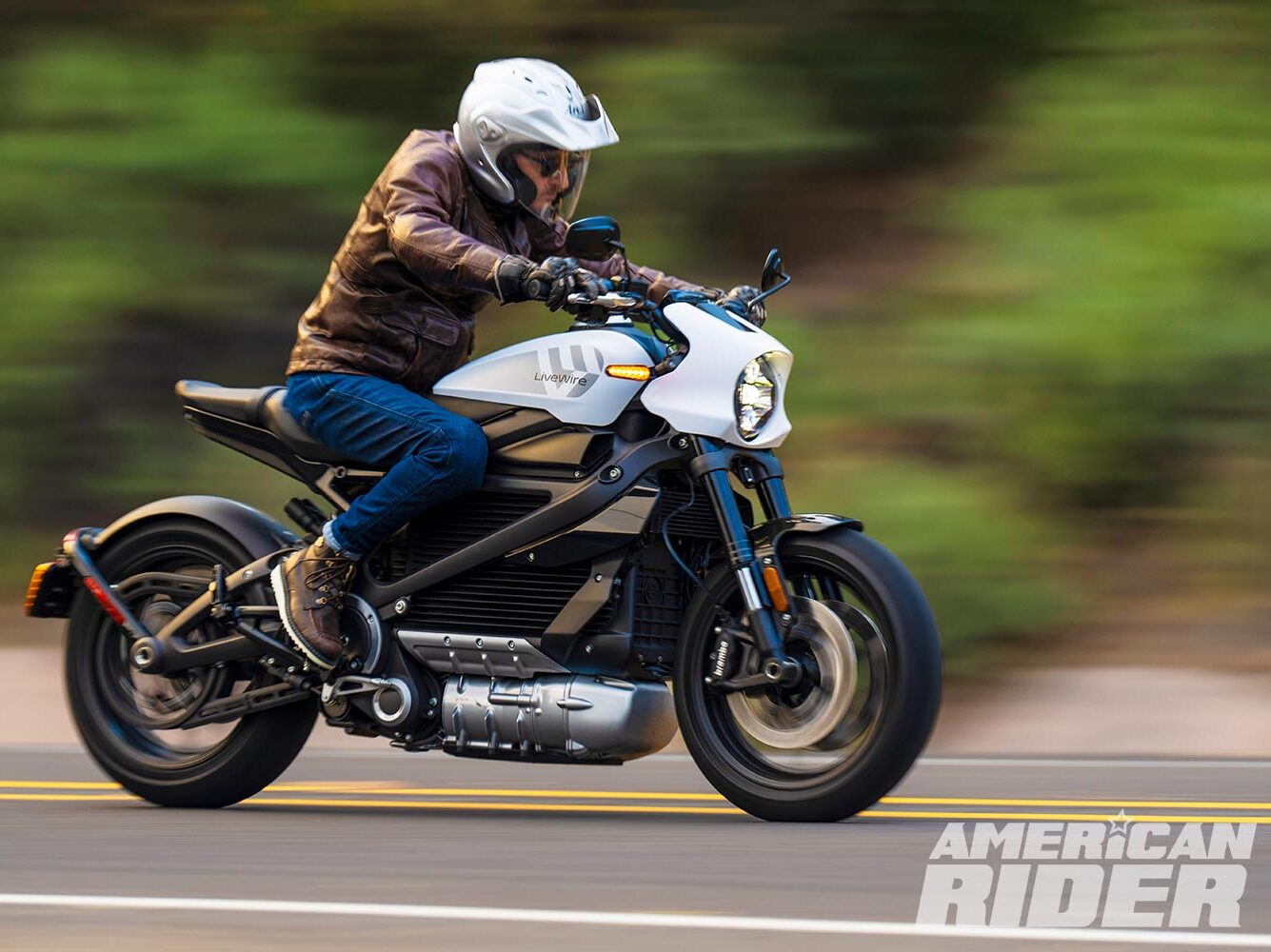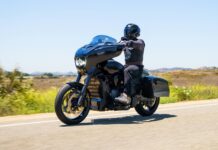Photos by James Martinec
Add electric motorcycles to the list of controversial topics riders have sharp disagreements about, like Japanese motorcycles and 4-cylinder engines.
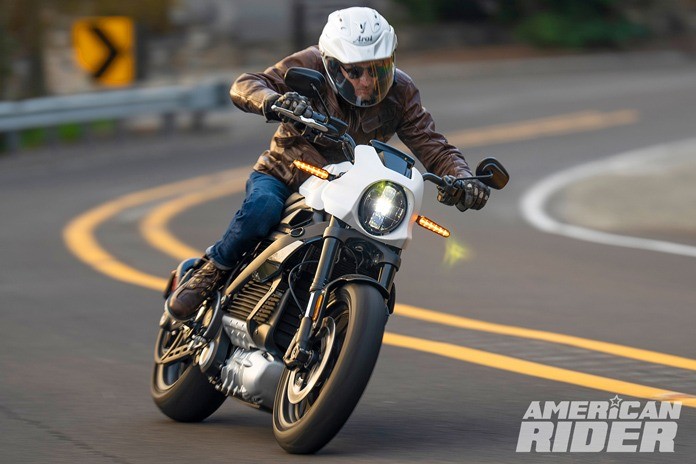
But here we are aboard Harley-Davidson’s LiveWire — or as it’s been known since 2022, the LiveWire One. Like many, I’ve been skeptical of anything not powered by internal combustion. A “real” engine is a living thing, literally breathing air and fuel that transforms into the speed we enjoy. An electric motor seems more at home in a washing machine than a motorbike.
I’ve spent nearly half a century riding with explosions between my legs… Uh, let me rephrase that: Internal combustion engines (ICE) have powered my moto adventures for almost five decades, and I’ve learned to be passionate about the way they produce power and the involvement they require from a rider to extract their potential.
Surely a grizzled vet won’t be able to find joy in riding an electric motorcycle, right?
Whirr Not Worthy
There’s no “firing up” a LiveWire, nor any sort of potato. Powering it on brings forth a vague electronic sound along with a distant pulsing vibration through the seat to remind riders that the throttle is armed and ready to fire. Familiarity is provided by switchgear, mirrors, and grips we recognize from traditional Harleys. Burly chrome hand levers that look great on Softails appear out of place on such a high-tech vehicle.

It should come as no surprise that an electric bike is easy to operate. Just power it up and twist and go, with no oil-warming necessary, no clutch actuation to manage, and no shifter to prod. You’ll instinctively reach for a clutch lever that doesn’t exist – repeatedly.
Related: LiveWire Reveals S2 Del Mar Electric Motorcycle
Anyone who can ride a bicycle and is able to keep the 562-lb LiveWire upright can ride this thing. A device so simple is a stark contrast for riders who have spent years switching on fuel taps, fiddling with carburetor choke levers, shifting gears, and blipping throttles at stoplights. The One is like a humanoid alien: familiar but different.

As a single-track vehicle, its dynamics are identical to what we’ve grown accustomed to from standard-style motorcycles. Its steering geometry is sharper than any Harley, with a rake angle of 24.5 degrees and 4.3 inches of trail, creating a more agile machine.
Engine?
Nope, electric vehicles are powered by motors. Technically, an ICE isn’t a motor, but let’s save that debate for another day. The LiveWire’s “Revelation” motor doesn’t thump or shake, but it does throw down with a power surge that’s bewildering to ICE devotees.
No matter the speed, thrust is instantly provided by a purported 100 hp and 84 lb-ft. Harley says it sprints to 60 mph in just 3 seconds, and the tugging I felt at my arm sockets makes me a believer. Need more proof of speed? Famed dragracer Angelle Sampey rode a One through the quarter-mile in 11.2 seconds, an E.T. that would’ve been even quicker if the bike hadn’t hit its 110-mph speed governor before crossing the finish line.

More impressive is the One’s stupendous roll-on acceleration, with a jump from 60 to 80 mph said to require just 1.9 seconds. It’s mind-altering how one bike can be so docile and serene while cruising but then instantly thrill with wicked acceleration when adrenaline is demanded.
Power delivery is immediate but not direct – the motor controller doles out power as it sees fit, depending also on the ride mode selected. I created a custom mode that maximized power output, throttle response, and regenerative braking, the latter supplying deceleration that mitigates the need to use the brakes. A 6-axis IMU informs the computer’s brain to manage switchable traction control and cornering ABS, as well as the astute self-canceling turnsignals.
Engine sounds are missed on the One, but the atypical orientation of its drive system adds an audible and visceral element. Rather than a transverse motor simply driving a belt or chain, the One uses a longitudinal motor driving a bevel gear that changes drive orientation, which creates a mechanical gear whine as speeds increase.
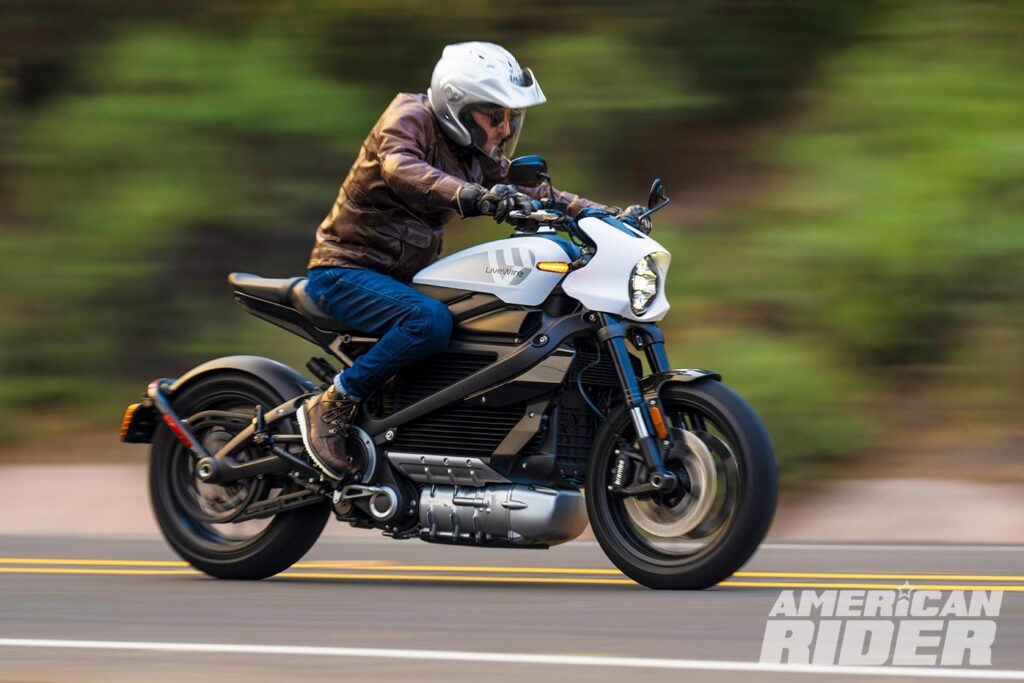
Gear Up
- Lid: Arai CT-Z
- Jacket: Dainese Harrison
- Gloves: Joe Rocket
- Pants: Alpinestars Copper V2
- Boots: Harley-Davidson Hagerman
Charge!
Let’s face it, e-bikes are always on an invisible electron tether that inhibits carefree travel. The One’s 15.4 kWh battery is akin to the size of a peanut tank, allowing a range of about 100 miles in mixed riding. During around-town use, I simply plugged it into household current (Level 1) at night and awoke to a full charge the next morning at minimal cost.

Longer trips require using public chargers where you can access Level 3 DC Fast Charging (DCFC), which can fill up the battery from empty in about an hour. Electricity isn’t as convenient as gas, but it’s cheaper, especially when charging at home. LiveWire owners get 500 kWh free charging at Electrify America DCFC stations, and free charging is also available at LiveWire dealers and several Harley ones.
To give the One a real-world test, I set out on a 200-mile ride. Most of the trip was spent on SoCal’s high-speed freeways, which is a scenario that quickly depletes batteries. I pre-planned a couple of stops at public chargers where the bike could get DCFC flow.
The One feels perfectly at home on highways, with its flat handlebar putting riders in a forward lean that helps cheat aerodynamic drag. Tank pads are welcome soft touchpoints for knees. Legroom is a bit tight for tall riders, but that’s to be expected for a bike with a relatively low seat height (30 inches) and a lot of cornering clearance. Its standard cruise control operates seamlessly, even more so than with an ICE powerplant.
After about 50 miles, I pulled into an EVgo charging station with 27% juice remaining in the battery. After plugging in, I got a cup of coffee and sorted through emails, and 33 minutes later, the battery had been boosted to 81%.
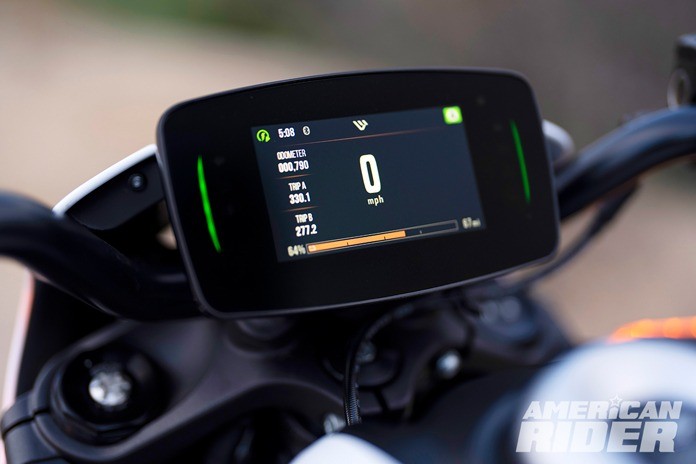
The next leg of the trip was spent exploring twisty canyon roads, which sucked up far fewer electrons than riding freeways. The One delights when unwinding corners, with 45 degrees of lean angle available before skimming footpegs. If you don’t ride with a protractor, let’s just say that’s a pretty steep tilt. Brembo brakes with ABS ably shed speed.
With the battery getting low, I routed myself to another public charger, limping in with just 4% showing on the color TFT instruments. Unfortunately, that charger only had Level 2 charging, not the Level 3 DCFC required for the One, so I had to gently nudge the bike a few more miles to a station with DCFC.
I popped in for a leisurely dinner while the One charged, emerging 75 minutes later to a full battery. That gave the bike a surplus of juice for the 80-mph freeway slog home, where it was plugged into household current for a fresh charge that cost just a few dimes.
Lovable Oddball
It’s probably safe to assume that few will trade in, say, a Panhead chopper for a One. But I encourage anyone to at least take one for a spin whenever an opportunity presents itself. It’s weird, yes, but it’s also wonderful.
The One is especially well-suited for bopping around town where range isn’t an issue. Sitting at a stoplight with riders on traditional ICE motorcycles, it seemed a bit archaic to watch them endure heat from the internal explosions between their legs, then futz with clutches and shifters as the light turned green.

With the One, there is no engine heat to deal with, and quick getaways require only twisting-and-going from the throttle grip. It also makes for an excellent passenger platform, as there’s no herky-jerky clutching and shifting. My kid enjoyed being picked up from school with the One, and she groaned when it had to be returned.
As for a trip to Sturgis, that’ll require one or more of these: patience, a trailer, or local residency. Bigger batteries can supply more range, but they inevitably add weight and cost. And with an MSRP of $22,799, the One is already kinda pricey.
That said, it is far less expensive than the bike’s original MSRP of $30k, and it’s right in line with (or cheaper than) prices for comparable e-bikes from Zero Motorcycles and Energica.
And neither of those brands originated at The Motor Company.

LiveWire One Specifications
- Colors: Liquid Black; Horizon White
- MSRP: $22,799
- Warranry: 2 yrs. on vehicle, 5 yrs. on battery
- Website: LiveWire.com
Motor
- Type: Liquid-cooled, Revelation internal permanent-magnet synchronous
- Horsepower: 100 hp (claimed)
- Torque: 84 lb-ft (claimed)
- Transmission: Clutchless single-speed
- Final Drive: Belt
Battery
- Type: Lithium-ion
- Maximum Capacity: 15.4 kWh
- AC Charge Time: 11 hours
- DC Fast-charging Time: 1.0 hours
- City Range: 146 miles
- Highway Range: 70 miles
Chassis
- Frame: Cast aluminum
- Rake/Trail: 24.5 degrees/4.3 in.
- Wheelbase: 58.7 in.
- Seat Height: 30.0 in.
- Suspension, Front: Fully adjustable Showa Big Piston 43mm inverted fork; 4.5 in. travel
- Suspension; Rear: Fully adjustable Showa monoshock; 4.5 in. travel
- Brakes, Front: 300mm discs w/ radially mounted Brembo 4-piston monoblock calipers, ABS
- Brake, Rear: 260mm floating disc w/ dual-piston caliper, ABS
- Wheels: Split 5-spoke cast aluminum
- Tires (F/R): Michelin Scorcher Sport; 120/70-17, 180/55-17 rear
- Curb Weight: 562 lb


